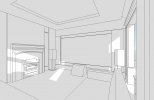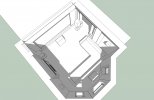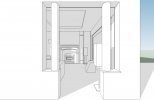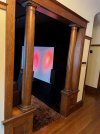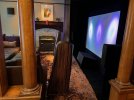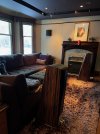- Joined
- Jan 27, 2019
- Messages
- 7,342
- Likes
- 12,315
Hey folks,
I'd like to use my listening room for a question about acoustics.
Back in around 2009 or so I did a total reno of our living room turning it in to a dual-use Home Theater and 2 channel listening room. It wasn't an easy sell for my wife as it's the very first room you see from the hallway when entering the house, but she came around and enjoyed the results too.
I made the goal maniacally difficult by insisting the room work well for a home theater and my separate 2 channel system. So there are separate home theater speakers, stand mounted monitors L/R, a very large Center channel, and surround speakers etc.
I used to have my speakers toward the bay window side of the room, with the listening sofa opposite against what is now my projection screen wall. Having to flip the seating and 2 channel speakers 180 degrees provided some challenges, not the least that it put some more restrictions on placement of the 2 channel speakers, as they now threatened to block passage in and out of the entrance-way. Fortunately, the narrow range of placement (distance to listening sofa) that allows easy passage in and out has also been excellent for great sound.
Part of what makes the room sound excellent is that it was renoed with the input of an acoustician, so there are various strategic placements (most hidden) of acoustic treatment.
BUT...and this is the main point of the post....as you can see there is a significant open entrance area to the hallway, near the Right speaker.
The room is 13 feet wide by 15 feet deep (15 feet from the center of the screen wall to the bay window behind the listening sofa). The room opening
is 5 1/2 feet wide.
My question is: what are the likely sonic consequences for bass frequencies (or any other frequencies) in this set up, given that room opening?
How much might this room opening account for the fact I seem to get, at least subjectively, mostly smooth sound down in to the bass frequencies for any speaker I've tried in those positions, large and small?
Apparently room acoustics are pretty predictable when you are dealing with, say, a standard rectangular, closed room. They get harder to predict when you add things like those angled bay windows behind the listening sofa. They get harder to predict still (I believe) when you have a big room opening like that as well.
One reason I ask is that in all the talk of "fitting the speaker to the room" - e.g. not putting a full range floor standing speaker in a room that is too small and overloading the bass frequencies etc - it's hard to know if, in practice, I should consider my room a "small to medium sized room" or if it is in effect a "big room" in terms of what the bass frequencies see in regards to that room opening giving those frequencies "more room to breath" as it were.
I certainly did have conversations about this with the acoustician, but that was 13 years ago, hard to remember his exact replies, but I do remember he said the room opening had a significant influence.
Please weigh in with any wisdom on this subject. Thanks.
(Photos supplied are some original plan drawings, and then a few photos I snapped today :
I'd like to use my listening room for a question about acoustics.
Back in around 2009 or so I did a total reno of our living room turning it in to a dual-use Home Theater and 2 channel listening room. It wasn't an easy sell for my wife as it's the very first room you see from the hallway when entering the house, but she came around and enjoyed the results too.
I made the goal maniacally difficult by insisting the room work well for a home theater and my separate 2 channel system. So there are separate home theater speakers, stand mounted monitors L/R, a very large Center channel, and surround speakers etc.
I used to have my speakers toward the bay window side of the room, with the listening sofa opposite against what is now my projection screen wall. Having to flip the seating and 2 channel speakers 180 degrees provided some challenges, not the least that it put some more restrictions on placement of the 2 channel speakers, as they now threatened to block passage in and out of the entrance-way. Fortunately, the narrow range of placement (distance to listening sofa) that allows easy passage in and out has also been excellent for great sound.
Part of what makes the room sound excellent is that it was renoed with the input of an acoustician, so there are various strategic placements (most hidden) of acoustic treatment.
BUT...and this is the main point of the post....as you can see there is a significant open entrance area to the hallway, near the Right speaker.
The room is 13 feet wide by 15 feet deep (15 feet from the center of the screen wall to the bay window behind the listening sofa). The room opening
is 5 1/2 feet wide.
My question is: what are the likely sonic consequences for bass frequencies (or any other frequencies) in this set up, given that room opening?
How much might this room opening account for the fact I seem to get, at least subjectively, mostly smooth sound down in to the bass frequencies for any speaker I've tried in those positions, large and small?
Apparently room acoustics are pretty predictable when you are dealing with, say, a standard rectangular, closed room. They get harder to predict when you add things like those angled bay windows behind the listening sofa. They get harder to predict still (I believe) when you have a big room opening like that as well.
One reason I ask is that in all the talk of "fitting the speaker to the room" - e.g. not putting a full range floor standing speaker in a room that is too small and overloading the bass frequencies etc - it's hard to know if, in practice, I should consider my room a "small to medium sized room" or if it is in effect a "big room" in terms of what the bass frequencies see in regards to that room opening giving those frequencies "more room to breath" as it were.
I certainly did have conversations about this with the acoustician, but that was 13 years ago, hard to remember his exact replies, but I do remember he said the room opening had a significant influence.
Please weigh in with any wisdom on this subject. Thanks.
(Photos supplied are some original plan drawings, and then a few photos I snapped today :

